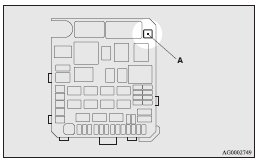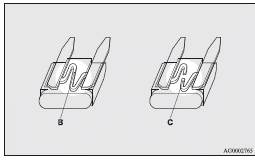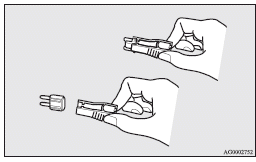Fuse replacement
1. Before replacing a fuse, always turn off the electrical circuit concerned
and place the ignition switch in the “LOCK” position.
2. Remove the fuse puller (A) from the inside of the fuse box in the engine compartment.

3. Referring to the fuse load capacity table, check the fuse pertaining to the problem.

B- Fuse is OK
C- Blown fuse
![]() Note
Note
► If any system does not function but the fuse corresponding to that system is normal, there may be a fault in the system elsewhere. We recommend you to have your vehicle checked.
4. Insert a new fuse of the same capacity by using the fuse puller and insert the fuse at the same place in the fuse block.

![]() Caution
Caution
► If the newly inserted fuse blows again after a short time, we recommend
you to have the electrical system checked to find the cause and rectify it.
► Never use a fuse with a capacity larger than that specified or any substitute,
such as wire, foil, etc.; doing so will cause the circuit wiring to heat up and
could cause a fire.
See also:
To unlock
Press the UNLOCK switch (2). All the doors and the rear hatch will be unlocked.
If the front room lamp switch (if so equipped) is in the “DOOR” position or the
rear room lamp switch (except fo ...
Turbocharger operation
CAUTION
• Do not run the engine at high speeds (for example, by revving it or by accelerating
rapidly) immediately after starting it.
• Do not stop the engine immediately after high-speed or ...
Washer fluid
Open the washer fluid reservoir cap and check the level of washer fluid with
the dipstick.
If the level is low, replenish the container with washer fluid.
NOTE
• The washer fluid container s ...
